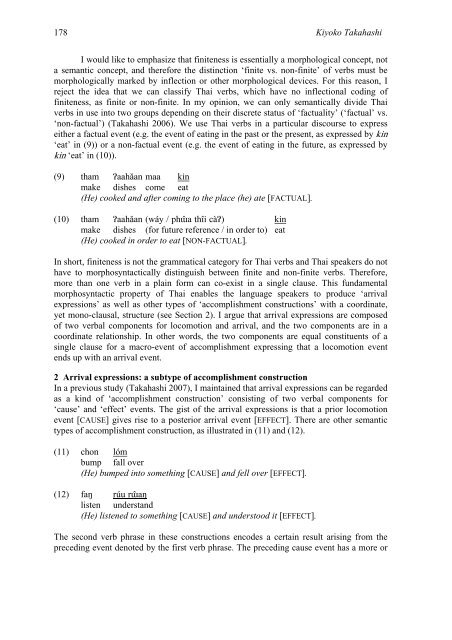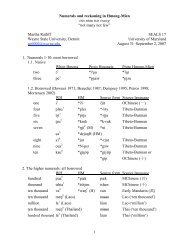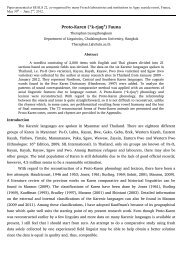proto-southwestern-tai revised: a new reconstruction - seals 22
proto-southwestern-tai revised: a new reconstruction - seals 22
proto-southwestern-tai revised: a new reconstruction - seals 22
You also want an ePaper? Increase the reach of your titles
YUMPU automatically turns print PDFs into web optimized ePapers that Google loves.
178 Kiyoko Takahashi<br />
I would like to emphasize that finiteness is essentially a morphological concept, not<br />
a semantic concept, and therefore the distinction ‘finite vs. non-finite’ of verbs must be<br />
morphologically marked by inflection or other morphological devices. For this reason, I<br />
reject the idea that we can classify Thai verbs, which have no inflectional coding of<br />
finiteness, as finite or non-finite. In my opinion, we can only semantically divide Thai<br />
verbs in use into two groups depending on their discrete status of ‘factuality’ (‘factual’ vs.<br />
‘non-factual’) (Takahashi 2006). We use Thai verbs in a particular discourse to express<br />
either a factual event (e.g. the event of eating in the past or the present, as expressed by kin<br />
‘eat’ in (9)) or a non-factual event (e.g. the event of eating in the future, as expressed by<br />
kin ‘eat’ in (10)).<br />
(9) tham Ɂaahǎan maa kin<br />
make dishes come eat<br />
(He) cooked and after coming to the place (he) ate [FACTUAL].<br />
(10) tham Ɂaahǎan (wáy / phɯ̂ a thîi càɁ) kin<br />
make dishes (for future reference / in order to) eat<br />
(He) cooked in order to eat [NON-FACTUAL].<br />
In short, finiteness is not the grammatical category for Thai verbs and Thai speakers do not<br />
have to morphosyntactically distinguish between finite and non-finite verbs. Therefore,<br />
more than one verb in a plain form can co-exist in a single clause. This fundamental<br />
morphosyntactic property of Thai enables the language speakers to produce ‘arrival<br />
expressions’ as well as other types of ‘accomplishment constructions’ with a coordinate,<br />
yet mono-clausal, structure (see Section 2). I argue that arrival expressions are composed<br />
of two verbal components for locomotion and arrival, and the two components are in a<br />
coordinate relationship. In other words, the two components are equal constituents of a<br />
single clause for a macro-event of accomplishment expressing that a locomotion event<br />
ends up with an arrival event.<br />
2 Arrival expressions: a subtype of accomplishment construction<br />
In a previous study (Takahashi 2007), I main<strong>tai</strong>ned that arrival expressions can be regarded<br />
as a kind of ‘accomplishment construction’ consisting of two verbal components for<br />
‘cause’ and ‘effect’ events. The gist of the arrival expressions is that a prior locomotion<br />
event [CAUSE] gives rise to a posterior arrival event [EFFECT]. There are other semantic<br />
types of accomplishment construction, as illustrated in (11) and (12).<br />
(11) chon lóm<br />
bump fall over<br />
(He) bumped into something [CAUSE] and fell over [EFFECT].<br />
(12) faŋ rúu rɯ̂ aŋ<br />
listen understand<br />
(He) listened to something [CAUSE] and understood it [EFFECT].<br />
The second verb phrase in these constructions encodes a cer<strong>tai</strong>n result arising from the<br />
preceding event denoted by the first verb phrase. The preceding cause event has a more or





